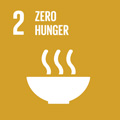- Docente: Loredana Baffoni
- Credits: 6
- SSD: AGR/16
- Language: Italian
- Teaching Mode: In-person learning (entirely or partially)
- Campus: Bologna
- Corso: Second cycle degree programme (LM) in Plant and Agricultural Biotechnology (cod. 6787)
Learning outcomes
At the end of the course, the student acquires theoretical and practical knowledge and skills for the use of microorganisms aimed at the sustainable management of agricultural and vegetable production. Furthermore, the student is able to define sustainable strategies based on the use of microorganisms for an efficient management of plant production and the maintenance of soil microbial biodiversity.
Course contents
The program includes an initial review of bacterial genetics and a small module on techniques for studying microbial communities with some notions of approach to NGS analysis. A module of microbial biotechnology applied to the environment and agriculture will follow.
a. Review of bacterial genetics. Plasmids, transposable elements, genome organization, gene regulation mechanisms in microorganisms, horizontal gene transfer (HGT). Microbial Biotechnology and legislative aspects related to the application of GMMs (Genetically Modified Microorganisms), recombinant DNA technology, cloning and expression vectors, metagenomics.
b. Microbial identification and study of environmental microbial communities through the tools of molecular microbial ecology (Sanger sequencing, NGS, qPCR).
c. Microbial Biotechnology applied to the environment and agriculture:
- Soil microbiota, rhizosphere, phyllosphere, plant and seed endophytes
- Plant Growth Promoting Microorganisms (PGPM): i) microbial mechanisms of direct growth promotion, biostimulation and biofertilization; ii) microbial mechanisms of indirect growth promotion, antagonistic microorganisms; iii) interaction and recruitment by the plant host.
- Microbial inoculants: production, quality parameters, agronomic effects.
- Associations between microorganisms and plants, nitrogen fixation and nitrogen-fixing symbiosis (examples of engineering to increase nodulation capacity)
- Insect-associated microorganisms. Symbiotic control of harmful insects or vectors of phytopathogens
- Bioremediation (in-situ and ex-situ treatments of contaminated soils, advantages and disadvantages of bioremediation)
- Metals and their biological role, genetics and biochemistry of microorganisms' resistance to metals, role of microorganisms in the bio-absorption of metals
- Biological treatment of wastewater
Readings/Bibliography
Use of the slides provided on the Virtuale platform.
Scientific articles related to the topics will be made available on Virtuale
For further information, the following texts are recommended:
Microbiologia Agroambientale - B. Biavati, C. Sorlini (Casa Editrice Ambrosiana)
J Willey, L Sherwood, CJ Woolverton (10th edition 2017) Prescott's Microbiology. Published by McGraw-Hill Education.
JK Patra, CN Vishnuprasad, G Das (2018). Microbial Biotechnology: Applications in Agriculture and Environment. Springers.
Arora, N.K., & Bouizgarne, B. (Eds.). (2022). Microbial Biotechnology for Sustainable Agriculture Volume 1 (Vol. 33). Springer Nature.
Teaching methods
For the theoretical component, teaching will be based on PowerPoint presentations and open discussions. The total number of hours will be divided as follows: 60% lectures and 40% complementary activities, including:
-
Laboratory activities (isolation of endophytic bacteria and AFLP analysis of isolates)
-
Seminars on specific topics (in-depth study of laboratory techniques, DNA databases, in-silico analysis, etc.)
-
Sequence analysis using free software
-
Videos
The aim of the complementary activities is to link the theoretical component of the course with its practical aspects.
Given the types of activities and teaching methods adopted, attendance in this learning activity requires all students to complete modules 1 and 2 in e-learning mode, as well as to attend Module 3, which provides specific training on health and safety in study environments. Information on the dates and attendance procedures for Module 3 is available in the dedicated section of the degree programme’s website.
Assessment methods
The learning assessment will be conducted through a final oral examination, aimed at verifying the acquisition of the expected knowledge and skills. The exam will consist of three questions on the course content: one on the genetics section, one on the techniques section, and one on the section on microbial biotechnologies applied to the environment and agriculture.
The assessment will evaluate not only the knowledge of the topics covered in the course programme, but also the ability to apply the knowledge acquired, to make logical and deductive connections between topics, and to use correct language and appropriate technical terminology.
Students with learning disorders and\or temporary or permanent disabilities: please, contact the office responsible (https://site.unibo.it/studenti-con-disabilita-e-dsa/en/for-students) as soon as possible so that they can propose acceptable adjustments. The request for adaptation must be submitted in advance (15 days before the exam date) to the lecturer, who will assess the appropriateness of the adjustments, taking into account the teaching objectives.
Teaching tools
PC, projector and blackboard are available for lessons. For the complementary activities, teaching laboratories available on the Imola Campus will be used.
Office hours
See the website of Loredana Baffoni
SDGs




This teaching activity contributes to the achievement of the Sustainable Development Goals of the UN 2030 Agenda.
